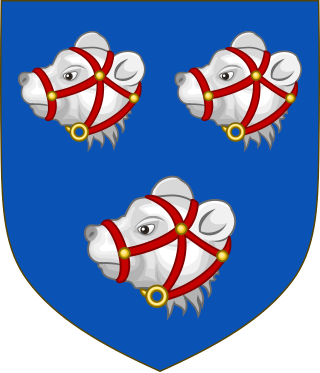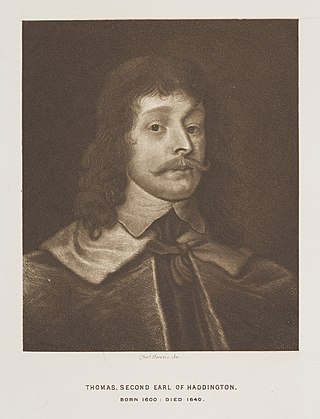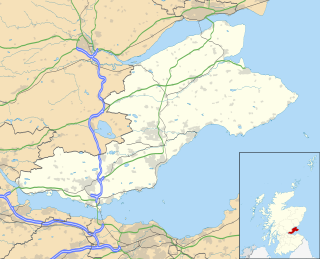
Duke of Hamilton is a title in the Peerage of Scotland, created in April 1643. It is the senior dukedom in that peerage, and as such its holder is the premier peer of Scotland, as well as being head of both the House of Hamilton and the House of Douglas. The title, the town of Hamilton in Lanarkshire, and many places around the world are named after members of the Hamilton family. The ducal family's surname, originally "Hamilton", is now "Douglas-Hamilton". Since 1711, the dukedom has been held together with the Dukedom of Brandon in the Peerage of Great Britain, and the dukes since that time have been styled Duke of Hamilton and Brandon, along with several other subsidiary titles.

Earl of Gowrie is a title that has been created twice, once in the Peerage of Scotland and once in the Peerage of the United Kingdom, both times for members of the Ruthven family. It takes its name from Gowrie, a historical region and ancient province of Scotland. On 23 August 1581, William Ruthven, 4th Lord Ruthven, was created Earl of Gowrie by James VI, King of the Scots. He was executed for high treason, attainted and his peerages forfeited on 28 May 1584. Two years later in 1586, the attainder was reversed and his son, the second Earl, was restored as Earl of Gowrie and Lord Ruthven, but both peerages were forfeited after the alleged plot and subsequent death of the second Earl's younger brother, the third Earl, in 1600.

Lord Balfour of Burleigh, in the County of Kinross, is a title in the Peerage of Scotland. It was created in 1607 for Sir Michael Balfour.

Earl of Carrick is the title applied to the ruler of Carrick, subsequently part of the Peerage of Scotland. The position came to be strongly associated with the Scottish crown when Robert the Bruce, who had inherited it from his maternal kin, became King of the Scots in the early 14th century. Since the 15th century, the title of Earl of Carrick has automatically been held by the heir apparent to the throne, thus the current holder of the title is Prince William, Duke of Rothesay.

Earl of Cromartie is a title that has been created twice, both for members of the Mackenzie family. It was first created as Earl of Cromarty in the Peerage of Scotland in 1703 for Sir George Mackenzie, 2nd Baronet, but his titles were forfeited after the Jacobite rising of 1745. It was recreated in 1861 in the Peerage of the United Kingdom for Anne Sutherland-Leveson-Gower, Duchess of Sutherland. Since 1979, the Earl of Cromartie has been chief of Clan Mackenzie.

Sir John Keith, 1st Earl of Kintore PC (Scot), was a Scottish nobleman.

Clan Drummond is a Highland Scottish clan. The surname is rendered "Druimeanach" in modern Scottish Gaelic.

Clan MacDowall or MacDouall is a Lowlands Scottish clan.

Clan Oliphant is a Highland Scottish clan.
William de Brus, 3rd Lord of Annandale, was the second but eldest surviving son of Robert de Brus, 2nd Lord of Annandale.

Clan Forbes is a Highland Scottish clan from Aberdeenshire, Scotland.

Kenneth Mackenzie, Lord Fortrose was a British politician and Chief of the Highland Clan Mackenzie.

George Hay, 7th Earl of ErrollPC was a Scottish nobleman and politician.

Clan Bethune is a name for one the Scottish families using the last name of Bethune, in this case descendants of the lairds of Balfour in Fife, an estate in the Lowlands parish of Markinch. Originating before the year 1000 in the town of Béthune, then in the county of Flanders, over the centuries the pronunciation of the family name shifted from the original French bay-tune to the Scots bee-t'n, usually written Beaton. From about 1560, members of the family started using the French spelling again.
John Balfour, 3rd Lord Balfour of Burleigh was a Scottish nobleman. He was educated in France; and has been traditionally and erroneously styled Covenanter John Balfour, the Covenanter being John Balfour of Kinloch.

John Stewart, 1st Earl of Angus, Lord of Bonkyl, jure uxorisLord of Abernethy was a medieval Scottish nobleman.

Thomas Hamilton, 2nd Earl of Haddington was a Scottish nobleman.

The Barony of Denboig is a Scottish feudal barony Parish in the county of Fife in Scotland. In the medieval period the church and parish of Dunbog originally belonged to the Abbey of Arbroath in Angus. Arbroath or Aberbrothock Abbey was initially a Cluniac Priory founded by King William the Lion in 1178, later, around 1233, it was taken over by Tironsian monks from Kelso Abbey. Arbroath Abbey is famed as the site of the signing of the Declaration of Independence in 1320. Within the parish of Dunbog stood the Cistercian Priory of Cadvan, a cell of nearby Balmerino Abbey. Balmerino Abbey which lies on the shores of the River Tay, across from Dundee, was founded as a Cistercian house by the widow of King William the Lion in 1236. The only building of historical significance in modern Dunbog is Dunbog Mansion house which is built on the site of Cadvan Priory. At one point it was occupied by Cardinal David Beaton [born 1494- died 1546].

John Stewart, Earl of Carrick, Lord Kinclaven was a Scottish nobleman, the third son of Robert, Earl of Orkney, a bastard son of King James V.
Lord Basil Hamilton was a Scottish aristocrat who drowned trying to save his servant.















